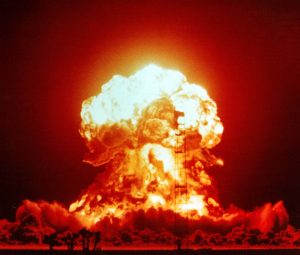The Trump administration’s repeated push for a nuclear arms control agreement with China failed due in equal parts to bad faith and ignoring China. Beijing has consistently refused to entertain even the prospect of talks regarding its nuclear arsenal, but the new Biden administration can still pursue successful arms control with China without mentioning nuclear stockpiles. A good faith effort to ratify the Comprehensive Test Ban Treaty (CTBT) would be a remarkable first step on joint nuclear arms control between Beijing and Washington, and a bigger step in establishing cooperation to preclude conflict between the two countries. It would also signal broader commitments to reducing threat of nuclear war, enhancing nuclear non-proliferation, and protecting the climate.
Contemporaneous ratification of the CTBT sidesteps most of the barriers that direct arms control talks might suffer from. Under the previous Trump administration, the United States upended several decades of international norms surrounding nuclear weapons, forcing the United States’ reputation as a reliable negotiation partner to suffer. The Trump administration backed out of the Intermediate Nuclear Forces Treaty with Russia, manufactured and deployed a new submarine-launched low yield nuclear intercontinental range ballistic missile, threatened nuclear war with another nuclear state, and openly considered resuming nuclear testing.
China itself has repeatedly rejected arms control invitations. China refuses to entertain arms control initiatives until both Russia and the United States pare their nuclear stockpiles down to levels similar to China’s. U.S. Department of Defense estimates put China’s current nuclear warhead stockpile in the low 200s, hardly comparable to the United States’ 5,800 and Russia’s 6,300. Drastic reductions aren’t expected anytime soon, much less in the next four years,
There’s also little urgency on either side to resolve any outstanding security issues through nuclear arms control agreements. Previous agreements were born out of the precariousness of the Cold War, a constant nuclear will they/won’t they between the United States and the Soviet Union and the nuclear arms race. Previous nuclear arms control agreements increased transparency and limited stockpiles to reduce tensions and the possibility of nuclear mishaps; it’s not clear that there is an agreement that could accomplish anything similar today.
But it would benefit both countries to move forward together on something, even if the greater issues of nuclear arms control remain tentatively out of reach. Ratifying the Comprehensive Test Ban Treaty together, something neither country has yet done, would be a tremendous signal of threat reduction cooperation and a significant step toward future arms control engagement. Ratifying the CTBT together would also provide an important incentive to continue working together toward nuclear threat reduction while providing both countries with the necessary institutional knowledge for future collaboration.
Ratifying the CTBT would reduce the possibility that either country might someday resume testing nuclear weapons. The Trump administration had threatened to do so, and nuclear experts warned that it could trigger a wave of tests by numerous nuclear capable nations. Live testing presents significant challenges to threat reduction. It affords nuclear countries the possibility to test more sophisticated weapon designs, opening up the possibility of future arms races as states compete for a technological edge. Testing invariably requires production, reestablishing the nuclear weapons supply chains needed for testing and increasing the risk of proliferation.
Nuclear testing is also a grave threat to the environment. U.S. nuclear testing wreaked havoc on natural habitats and Pacific Islander and American communities. Ratifying the CTBT would signal a serious intent to better steward the environment and preserve it for future generations. It would be a welcome symbol after the Biden administration rejoins the Paris Climate Agreement, bolstering the administration’s support of climate protection.
Ratification would also be an opportunity to encourage other countries to join as well. Egypt, Israel, and Iran have all signed but not ratified the CTBT but may reconsider with leadership from both China and the United States. India, Pakistan, and North Korea have not signed the treaty and would be more difficult to persuade. But the ratification would present Beijing and Washington with the momentum and opportunity to jointly open dialogue with these countries or apply requisite pressure. Admittedly, the histories of conflict and poor relations between these five countries require a Herculean effort; however, the treaty cannot be enacted without their signatures and ratifications.
The process wouldn’t be without its own difficulties. On the American side, Biden would need two-thirds of the U.S. Senate to approve a resolution of ratification to proceed. This requires obtaining 16 votes yes votes from the opposition party, a tall order. But it’s not out of the question, and any effort to bolster both regional and national security should be met with serious consideration.
Jonathan Stutte is a staff writer for Charged Affairs, the Young Professionals in Foreign Policy’s foreign policy journal, and a freelance editor.
































